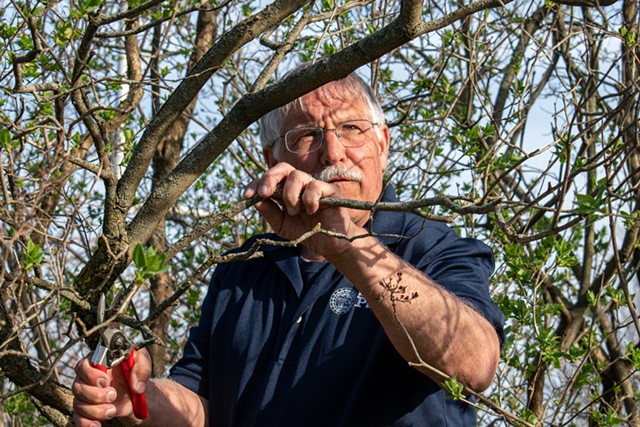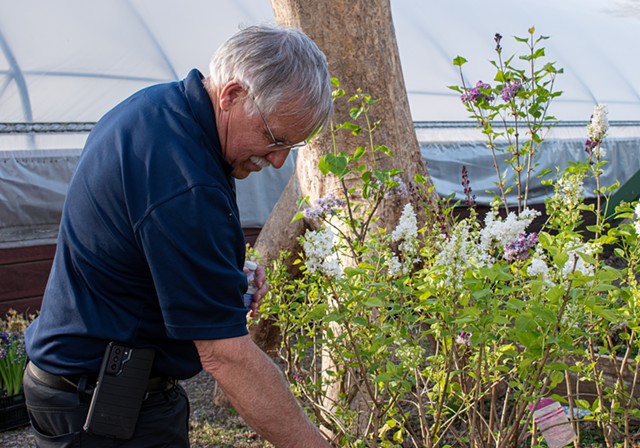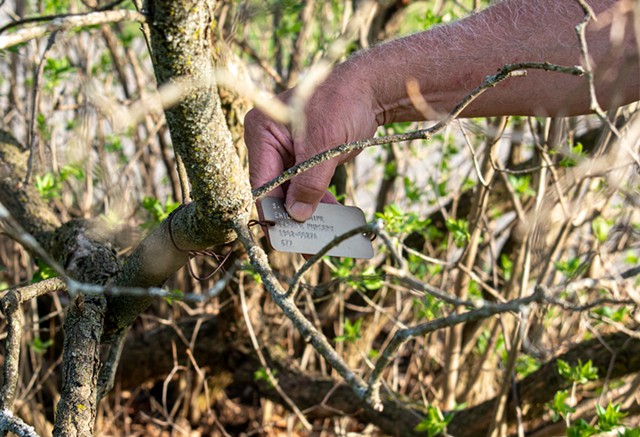Mark Quinn is the master green thumb who helps Flower City live up to its name
By Rebecca Rafferty @rsrafferty[
{
"name": "500x250 Ad",
"insertPoint": "5",
"component": "15667920",
"parentWrapperClass": "",
"requiredCountToDisplay": "1"
}
]
On a rare 80-degree afternoon in April, Mark Quinn knelt before a bed of pansies in the shape of a starburst in Highland Park. The superintendent of horticulture for Monroe County Parks said the flowers had only recently been planted, and he needed to check the health of the blossoms.
“We grow 20,000 pansies, but we've actually got quite a few extra because the pansies weren't particularly good this year,” Quinn said. “If they're big, it takes less, probably 15 or 16,000. But if the plants themselves were small, we'd have to get more in there.”
The bed is just one small patch on the south-facing hill of the park that is home to the horticultural stars of Highland Park — more than 1,200 lilac bushes, some more than 100 years old, in 500 varietals with different shapes, colors, and scents.
Quinn leads the team of county workers who make the park pop with color each spring for the hundreds of thousands of visitors to the annual Lilac Festival, which this year runs from May 12 to May 21. The throngs of people who stick their noses in the lilac bushes and snap cheerful selfies have Quinn and his crew to thank.
The crowds invariably damage some of the team’s work, but Quinn is unfazed by it.
“Parks are for people,” he said with a smile and a shrug. “Yes, you put up to 500,000 people in this park, it's going to show that there were 500,000 people in this park. But the staff is pretty good at making any trampling or damage go away. We're not here for the lilacs, we're here for people that come see the lilacs.”
Strolling the hilly paths of the park, it’s easy to forget how much work goes into keeping the manicured place flush with florals. The paths are clear. Fallen trees are quickly removed and replaced. Lawns are mowed. The lilac bushes are trimmed to encourage blossoming lower to the ground. Left on their own, the flowers would blossom far above eye-level.
Maintaining Highland is a year-round process. Pruning the lilacs, for example, takes place after the last blossoms have fallen.
“We had somebody in the lilacs pruning throughout the winter, especially this winter, because it was actually fairly mild,” Quinn said. “Now, ideally, I'd tell somebody, if they were going to prune a lilac, the time to prune it is right after it blooms. But when you have 1,200 of them, that's not realistic. So, we prune whenever we can.”
On that unseasonably warm day, a persistent breeze offered relief from the humidity and rustled the park’s hundreds of trees and flowering shrubs to carry heady scents of blooming magnolia and cherry trees in the air. Birdsong and the hum of insects completed the picture of nature shrugging off winter.
Soon, the people will come.
They’ll come in droves through the soaring pines lining the steep staircase to the park’s entrance on South Goodman Street that lends the impression of walking into an open-air cathedral.
They’ll snake their way through the park’s hundreds of trees from around the world, some of which were planted by the designer of the park, the father of American landscape architecture, Frederick Law Olmsted.
“The genius and foresight of Olmstead is that he could envision what it would be like, but he wouldn’t have seen it like this in his lifetime,” Quinn said.
There will also be media. Lots of media.
Part of Quinn’s job is predicting the best blooms that make for ideal television news spots. There are some controlled aspects to that task, such as the bushes being planted on a south-facing, sandy hill with ample drainage.
But much of managing that crystal ball comes down to reading the fickle weather. Those few days of April heat gave way to cooler weather that will keep the blossoms at bay for a while longer, but Quinn said the blooms were falling into place.
He has had some practice with these predictions.
Quinn has been in his current position for 15 years, but his relationship with Highland Park stretches back to his previous work as supervisor for the parks and other positions he has held with Monroe County for nearly 40 years. His office is in the park.
For him, the park is a second home. From his perch, he watches the seasons change. He sees blooms as early as January some years, and as late as when the snow starts to fall. The earliest blooms are fragrant witch-hazel and magnolias, and late into the year, there are the roses and other annuals.
The hilly park is like an island oasis in an urban center year-round.
“There's little secluded valleys here that you can get into and you're just in the wilderness, but we're right in the city.” Quinn said. “You're really able to disconnect.”
Rebecca Rafferty is an arts writer for CITY. She can be reached at [email protected].
“We grow 20,000 pansies, but we've actually got quite a few extra because the pansies weren't particularly good this year,” Quinn said. “If they're big, it takes less, probably 15 or 16,000. But if the plants themselves were small, we'd have to get more in there.”
The bed is just one small patch on the south-facing hill of the park that is home to the horticultural stars of Highland Park — more than 1,200 lilac bushes, some more than 100 years old, in 500 varietals with different shapes, colors, and scents.
Quinn leads the team of county workers who make the park pop with color each spring for the hundreds of thousands of visitors to the annual Lilac Festival, which this year runs from May 12 to May 21. The throngs of people who stick their noses in the lilac bushes and snap cheerful selfies have Quinn and his crew to thank.
The crowds invariably damage some of the team’s work, but Quinn is unfazed by it.
“Parks are for people,” he said with a smile and a shrug. “Yes, you put up to 500,000 people in this park, it's going to show that there were 500,000 people in this park. But the staff is pretty good at making any trampling or damage go away. We're not here for the lilacs, we're here for people that come see the lilacs.”
Strolling the hilly paths of the park, it’s easy to forget how much work goes into keeping the manicured place flush with florals. The paths are clear. Fallen trees are quickly removed and replaced. Lawns are mowed. The lilac bushes are trimmed to encourage blossoming lower to the ground. Left on their own, the flowers would blossom far above eye-level.
Maintaining Highland is a year-round process. Pruning the lilacs, for example, takes place after the last blossoms have fallen.
“We had somebody in the lilacs pruning throughout the winter, especially this winter, because it was actually fairly mild,” Quinn said. “Now, ideally, I'd tell somebody, if they were going to prune a lilac, the time to prune it is right after it blooms. But when you have 1,200 of them, that's not realistic. So, we prune whenever we can.”
On that unseasonably warm day, a persistent breeze offered relief from the humidity and rustled the park’s hundreds of trees and flowering shrubs to carry heady scents of blooming magnolia and cherry trees in the air. Birdsong and the hum of insects completed the picture of nature shrugging off winter.
Soon, the people will come.
They’ll come in droves through the soaring pines lining the steep staircase to the park’s entrance on South Goodman Street that lends the impression of walking into an open-air cathedral.
They’ll snake their way through the park’s hundreds of trees from around the world, some of which were planted by the designer of the park, the father of American landscape architecture, Frederick Law Olmsted.
“The genius and foresight of Olmstead is that he could envision what it would be like, but he wouldn’t have seen it like this in his lifetime,” Quinn said.
There will also be media. Lots of media.
Part of Quinn’s job is predicting the best blooms that make for ideal television news spots. There are some controlled aspects to that task, such as the bushes being planted on a south-facing, sandy hill with ample drainage.
But much of managing that crystal ball comes down to reading the fickle weather. Those few days of April heat gave way to cooler weather that will keep the blossoms at bay for a while longer, but Quinn said the blooms were falling into place.
He has had some practice with these predictions.
Quinn has been in his current position for 15 years, but his relationship with Highland Park stretches back to his previous work as supervisor for the parks and other positions he has held with Monroe County for nearly 40 years. His office is in the park.
For him, the park is a second home. From his perch, he watches the seasons change. He sees blooms as early as January some years, and as late as when the snow starts to fall. The earliest blooms are fragrant witch-hazel and magnolias, and late into the year, there are the roses and other annuals.
The hilly park is like an island oasis in an urban center year-round.
“There's little secluded valleys here that you can get into and you're just in the wilderness, but we're right in the city.” Quinn said. “You're really able to disconnect.”
Rebecca Rafferty is an arts writer for CITY. She can be reached at [email protected].
Speaking of...
More by Rebecca Rafferty
-

Beyond folklore
Apr 4, 2024 -

Partnership perks: Public Provisions @ Flour City Bread
Feb 24, 2024 -

Raison d’Art
Feb 19, 2024 - More »







